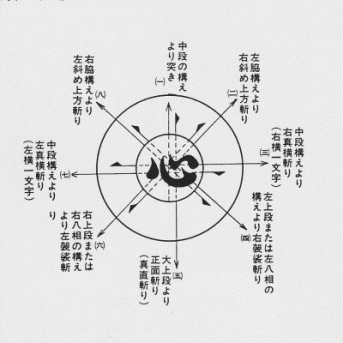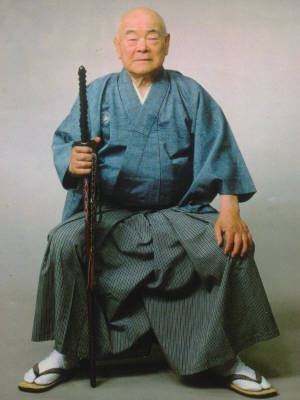
Born in Yamagata prefecture in 1912, Nakamura Taizaburo was a Taito Honbun Sha ("Nanpoheidan Yamashita Kirikomitai" - Southern Yamashita Army Group Assault Force, under the assignment of "Jissen Budo Kyokan", or, Fencing Instructor in Northern China during WWII.
For his lifelong contributions to the Japanese sword arts, especially Toyama Ryu Battodo, and for the development of his own sword style of Nakamura Ryu Battodo Happo Giri To-Ho, at age 63, Nakamura sensei received the coveted "Order of the Sacret Treasure".
Source:
" Essential Principals of Nakamura Ryu Iaido by Nakamura Taizaburo.
NAKAMURA RYU BATTO-DO

While teaching kenjutsu in northern China he was inspired with the thought that EJII HAPPO, the eight rules of calligraphy, could be applied to swordsmanship. As Nakamura Taizaburo practiced the ei character (this is to calligraphy what do-re-mi is to music), he saw in his mind that the eight strokes of the brush traced the trajectory of the word when cutting.
The first brush stroke, soku, is the thrust of the sword tip, the second stroke, roku, is the left and right horizontal cut; the third stroke, do, is the vertical cut; and so on.
When he gazed at the finished ei calligraphy, he could actually see the eight cuts of the sword. Through his years of learning and teaching fencing, he had sensed that there were few cuts in swordsmanship. When he contemplated the ei character, he was made to realize that there are only eight distinct cuts possible; any other technique, whatever artistic name it may have, is only a variation of the theme
.
The Inspiration
Eiji Happo transformed to happo giri, which is lucky since the Chinese character ei means eternal. In addition, the number eight is a favourable symbol in Chinese mythology, indicating both prosperity and good fortune. Therefore, the eight ways of cutting are innumerable and unending.
Nakamura Taizaburo began to organize his realization and ideas into a system of practical swordsmanship devoid of meaningless techniques. Throughout his search he found that most old-school styles do not use the kesagiri (downward diagonal cut).
He wondered how this could be omitted as the kesa is the most natural cut to make, yet it was not being taught in either kendo or iaido. This must be due to the lack of objective, logical thinking: just passing on the techniques without evaluation into their deeper meaning.
The Nakamura Ryu Iaido system is based on studies of how to bring the sword blade to a halt following a cut, how to parry, and how to progress to the next combative posture by utilizing the sword's kinetic energy.
Adding to the eight methodical cuts, he also incorporated eight defensive fighting postures or kamae.
The chiburi used in Toyama Ryu Battodo and Nakamura Ryu Battodo is actually an en garde position; the sword is snapped down, pointing slightly elevated at knee level. From this position one can maintain zanshin, as well as convert to a thrust should you need to.
In creating Nakamura Ryu Happogiri To-Ho he built a strong foundation for aspiring swordsmen, and having been able to draw on his extensive range of experiences, he researched test cutting to the fullest and with it laid the ground work for 21st century tameshigiri.
The Realization
Copyright (C) 2013 SSJS, Sei Do Kan
Nakamura Taizaburo, Soke & Hanshi 10th-dan Battodo.
1912 - 2013
Nakamura Taizaburo
Soke Nakamura Ryu Batto-do Happo Giri To-ho
Hanshi 10th-dan Battodo.

The realization: eiji happo
